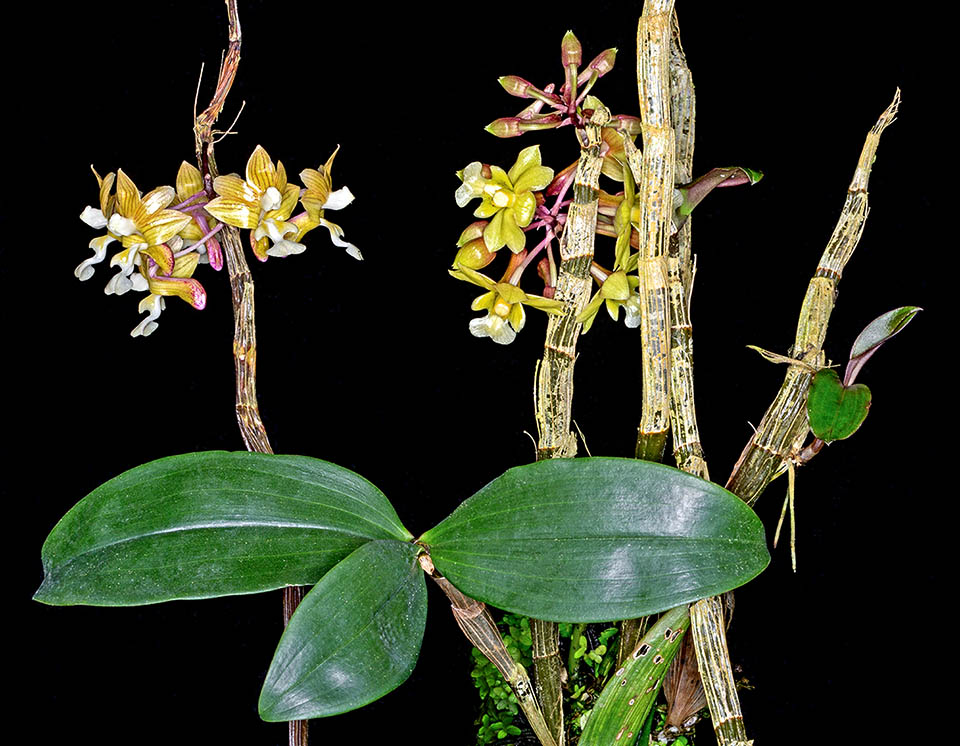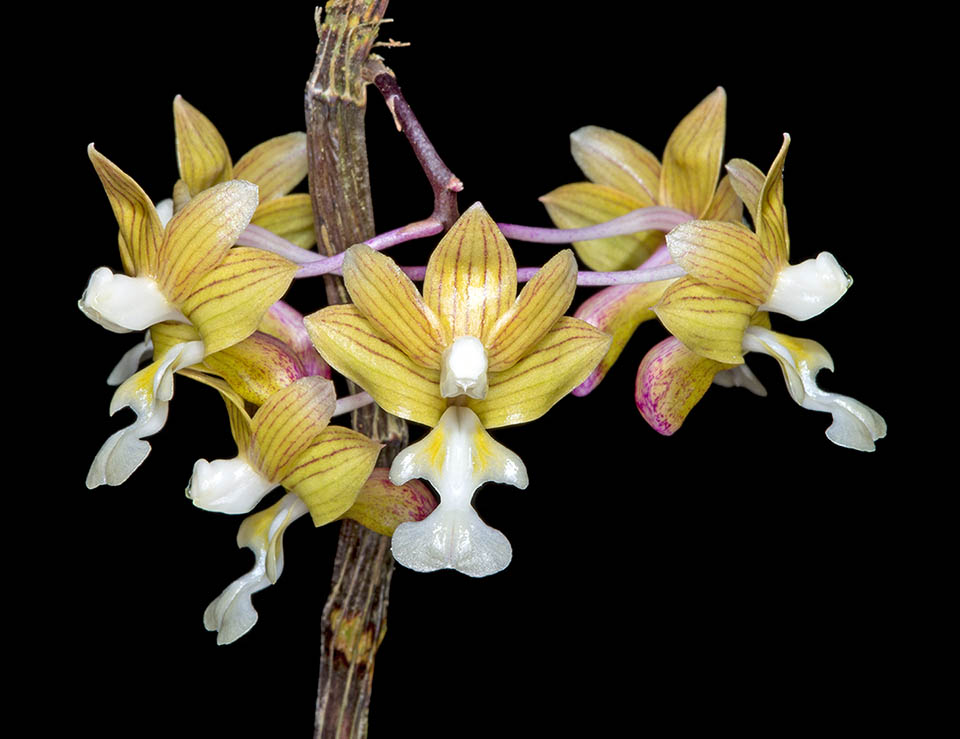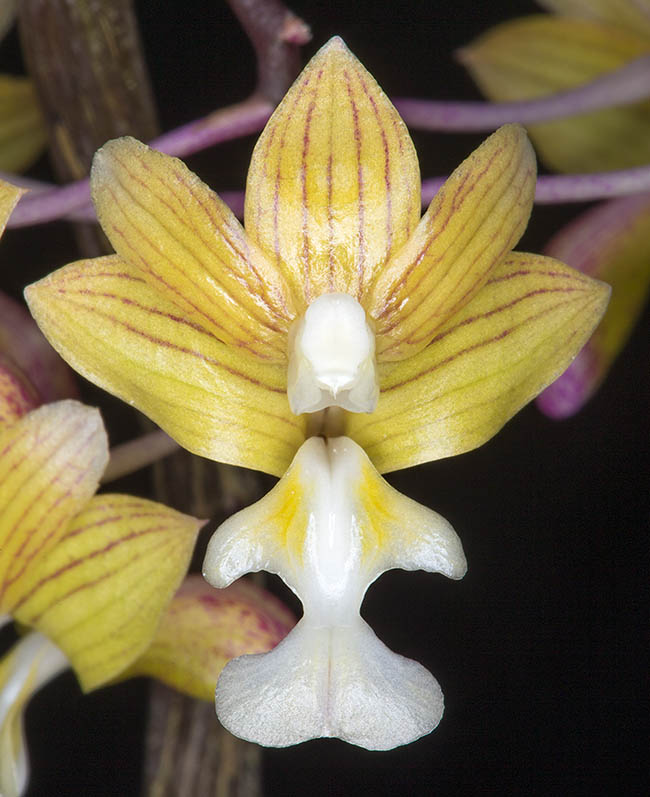Family : Orchidaceae

Text © Prof. Pietro Pavone

English translation by Mario Beltramini

Dendrobium crabro is an epiphyte of Borneo wet plains at about 500 m of altitude. The grooved deciduous stems, with about 6 internodes, measure 5-10 cm © G. Mazza
The species, Dendrobium crabro Ridl. belongs to the family Orchidaceae, subfamily Epidendroideae, tribe Malaxideae, subtribe Dendrobiinae, section Calcarifera.
The species, found in Sarawak (Borneo), was by Henry Nicholas Ridley (1855-1956) described in Journal of the Straits Branch of the Royal Asiatic Society, Singapore 50:133, 1908).
Dendrobium crabro is present in the whole island of Borneo, in the plains, at altitudes around 500 m above the sea level.
The name of the genus is the combination of the Greek substantives “δένδρον” (dendron), tree and “βίος” (bios), life due to the numerous species of the genus living on the trees getting nourishment from the humid atmosphere, typical to the equatorial forests.

An inflorescence. The back structure of the flower, that from profile recalls the abdomen of a hornet, has originated the name of the species © Giuseppe Mazza
The specific epithet, from the Latin “crabro”, means bumblebee, hornet, due to the shape of the spur (mentum).
The common name is Hornet Like Dendrobium.
Dendrobium crabro is a pseudo-bulbous epiphyte of medium size typical of the humid tropical biome. The stems are deciduous, sub-cylindrical, grooved, with about 6 internodes, 5-10 cm long and 0,7 or more cm broad, often of purple colour when young, somewhat cuneate at their extremities. The leaves are elliptical, obtuse, 7 cm long and 2,5 cm broad, slightly narrowed at the base.
The 2,5 cm big and fragrant flowers are carried by stems having no leaves that originate from the upper nodes. The flowers, subtended by an ovate bract, present a thin petiole, 2,5 cm long, pendulous.

The 2,5 cm flowers, fragrant, have greenish or golden with reddish veins, sepals and petals. The narrow based labellum has two ovate lobes followed by a choking that then widens in an ample fan-shaped terminal lobe © Giuseppe Mazza
The sepals are ovate, 0,5 cm long, and the petals, of similar shape, but shorter and more rounded at the extremities.
Usually, the sepals and the petals are of yellowish colour with red, at times of green hue, veins.
The mentum, the structure formed by the foot of the column and by the bases of the lateral sepals, is 1,3 cm long, restricted, dilated at the base and curved that resembles the abdomen of a hornet hence its specific name.
The 1,3 cm long labellum, has narrow base, linear, then suddenly dilated in two ovate lobes, oblong, rounded, of 1 cm of diameter in the expanded part, then narrows to widen again in an ample terminal fan-shaped fan.
Between the lobes, the veins swell to form a callus.
The column is largely dilated.
The anther is conical with a big apex.
The stigma is cordate, big, with high margin, ample and thick.
The labellum and the column are white.
Blooming occurs in late spring.
Dendrobium crabro is a species protected from commerce and as such inserted in the Appendix II of Washington Convention (CITES) that has the purpose of protecting the animal and vegetable species under risk of extinction, forbidding their export and their detention.
In cultivation the plant requires warm temperatures (20-26 °C), good light, but never direct sun, high atmospheric humidity (about 60-80%) and proper ventilation. It can be grown in pots having a proper diameter of 20-30 cm, full of a mix, well drained, based on fern or other material.
Waterings, with rainwater, by reverse osmosis or demineralized, must be abundant, as well as the fertilizations preferably monthly, with products specific for orchids, based on nitrogen, phosphorus and potassium (NPK) and with microelements.
It may be reproduced by seed, by micropropagation and by separation of the tufts on the vegetative regrowth with at least 3-4 pseudobulbs united with each other.
Synonyms: Eurycaulis crabro (Ridl.) M.A.Clem.
